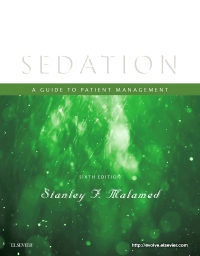
Sedation, 6th Edition
Paperback

Keep your classroom lessons up to date on the latest techniques in dental sedation and anxiety with Sedation: A Guide to Patient Management, 6th Edition. Written by sedation expert Stanley Malamed, DDS, this concise guide combines essential theory with "how-to" technical instruction to help your students master basic techniques in dental sedation and anxiety control. This new edition also incorporates the latest guidelines from the ADA and the American Society of Anesthesiologists, along with vivid images of the latest equipment and procedures used in dental practice today. There is also detailed discussion on how to modify typical treatment protocol to successfully treat different patient populations — including pediatric, geriatric, physically compromised, and medically compromised patients. In all, Malamed is the must-have guide for showing students how to safely sedate their dental patients and control anxiety.
-
- NEW! Extensive content revisions incorporate the most up-to-date information on the advances in sedation dentistry including the latest research, clinical experience, and literature.
- NEW! Updated photos and art reflect the latest equipment and procedures used in dental practice today.
- The latest practice guidelines established by the ADA and the American Society of Anesthesiologists for sedation by non-anesthesiologists are included throughout the text.
- Comprehensive coverage combines all aspects of sedation with essential theory and instruction to cover all the information students need to know to provide safe and effective dental care.
- Expert authorship from Stanley Malamed, DDS, provides students with experienced guidance across all areas of sedation dentistry and local anesthesia.
- Summary tables and boxes support visual learners and serve as useful review and study tools.
- Coverage of all potential patient groups details how to manage the pain and anxiety of pediatric, geriatric, physically compromised, and medically compromised patients along with the subtle changes that may be needed in normal treatment protocol.
-
- NEW! Extensive content revisions incorporate the most up-to-date information on the advances in sedation dentistry including the latest research, clinical experience, and literature.
- NEW! Updated photos and art reflect the latest equipment and procedures used in dental practice today.
-
SECTION I: INTRODUCTION
1. Pain and Anxiety in DentistrySECTION II: SPECTRUM OF PAIN AND ANXIETY CONTROL
2. Introduction to Sedation
3. The Spectrum of Pain and Anxiety Control
4. Physical and Psychological Evaluation
5. Monitoring during Sedation
6. Nondrug Techniques: Iatrosedation and HypnosisSECTION III: ORAL, RECTAL, AND INTRAMUSCULAR SEDATION
7. Oral Sedation
8. Rectal Sedation
9. Sublingual, Transdermal, and Intranasal Sedation
10. Intramuscular SedationSECTION IV: INHALATION SEDATION
11. Inhalation Sedation: Historical Perspective
12. Pharmacosedation: Rationale
13. Pharmacology, Anatomy, and Physiology
14. Inhalation Sedation Equipment
15. Inhalation Sedation: Techniques of Administration
16. Inhalation Sedation: Complications
17. Contemporary Issues Surrounding Nitrous Oxide
18. Practical Considerations
19. Teaching Inhalation Sedation: History and Present Guidelines
SECTION V: INTRAVENOUS SEDATION
20. Intravenous Sedation: Historical Perspective
21. Intravenous Moderate Sedation: Rationale
22. Armamentarium
23. Anatomy for Venipuncture
24. Venipuncture Technique
25. Pharmacology
26. Intravenous Moderate Sedation: Techniques of Administration
27. Intravenous Sedation: Complications
28. Practical Considerations
29. Guidelines for TeachingSECTION VI: GENERAL ANESTHESIA
30. Fundamentals of General Anesthesia
31. Armamentarium, Drugs, and TechniquesSECTION VII: EMERGENCY PREPARATION AND MANAGEMENT
32. Preparation for Emergencies
33. Emergency Drugs and Equipment
34. Management of EmergenciesSECTION VIII: SPECIAL CONSIDERATIONS
35. The Pediatric Patient
36. The Geriatric Patient
37. The Medically Compromised Patient
38. The Physically Compromised Patient
39. Neurologic Illnesses and Other Conditions
40. Medicolegal considerations
41. The Controversial Development of Anesthesiology in Dentistry



 as described in our
as described in our 